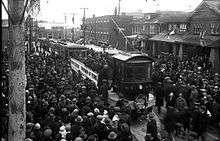Rogers Road streetcar line
The Rogers Road streetcar line was operated by the Toronto Transit Commission (TTC) from 1924 to 1974.

The Rogers Road streetcar line began operating on November 19, 1924. Predominantly serving the Township of York, the Township contracted the City of Toronto's TTC to run the line on its behalf. The initial route ran north from St. Clair Avenue, along Oakwood Avenue and turned west at Rogers Road, continuing to Dufferin Street. It was extended on August 29, 1925 to Bicknell Loop, located just east of Weston Road on Bicknell Avenue. After the Yonge Subway opened, in 1954, streetcars were extended eastward from Oakwood to St. Clair Station during rush hour.[1][2][3][4][5]
By 1974 many of the TTC's large fleet of PCC streetcars had worn out. The final Rogers Road streetcar travelled east to the St. Clair Carhouse on July 19, 1974. The route was replaced by the 63F Ossington trolley bus line beginning on July 21, 1974.[1][2]
According to Sean Marshall, closing the Rogers Road route was seen as a way to service other routes until the TTC could acquire new replacement vehicles. Transit advocate Steve Munro, however, has said that in 1974, while the TTC operated the service on the route, the infrastructure was the property of the Township of York – who had not been spending enough money to keep the rails in repair.[6]
References
- 1 2 Sean Marshall (2014-07-19). "Remembering the Rogers Road streetcar". Spacing.ca. Retrieved 2014-07-20.
At the end of rush hour, on Friday, July 19, 1974, the Rogers Road streetcar rattled its way east on Rogers Road, Oakwood Avenue, and St. Clair Avenue into St. Clair Carhouse on Wychwood Avenue for the last time.
- 1 2 James Bow (2013-02-17). "A History of the Rogers/Weston Streetcar Loops (Northlands, Avon and Bicknell)". Transit Toronto. Archived from the original on 2013-09-21. Retrieved 2014-07-20.
In 1972, the TTC decided to retain its streetcar operations within the City of Toronto, but needed to rebuild its fleet of PCCs to keep the system going until a replacement vehicle could be found. In order to have enough spares to maintain service while the rebuilds were continuing, it was decided to end streetcar service on Rogers Road.
- ↑ James Bow (2014-07-08). "The Township of York Railways (Deceased)". Transit Toronto. Archived from the original on 2013-12-07. Retrieved 2014-07-20.
The Rogers Road streetcar started at an off-street loop at Bicknell and Rogers Road, just a stone’s throw from Weston Road. There, it travelled east along Rogers Road, until it got to Oakwood Avenue. There, it turned south and ran to St. Clair, where it looped at Oakwood Loop.
- ↑ Sean Marshall, James Bow (2013-03-10). "Searching for Toronto's Transit Ghosts". Transit Toronto. Archived from the original on 2013-05-27. Retrieved 2014-07-20.
As for Rogers Road, the tracks from Old Weston Road east were removed soon after trolley buses took over service. However, rail remained along Rogers from the intersection with Old Weston Road up to, but not including Bicknell Loop. The track was not even covered over and remains plainly visible and in quite good condition.
- ↑ "2 Bicknell Avenue and the Bicknell Loop" (PDF). City of Toronto. 2010. Archived (PDF) from the original on 2-13-06-15. Retrieved 2014-07-21.
Part 2 on the Sketch was used by the Toronto Transit Commission (“TTC”) for an end of the line loop (“Bicknell Loop”) until it declared the Property surplus to TTC’s operational requirements on January 21, 2004.
Check date values in:|archive-date=(help) - ↑ Steve Munro (2014-07-19). "July 19, 1974: The End of the Line on Rogers Road". Archived from the original on 2014-07-22.
The Rogers Road car, the last remnant of the York Township Railways, was not saved with the rest of the streetcar system in 1972 because York (then a separate municipality) did not want to spend the extra money required to repave their street with streetcar tracks in it.